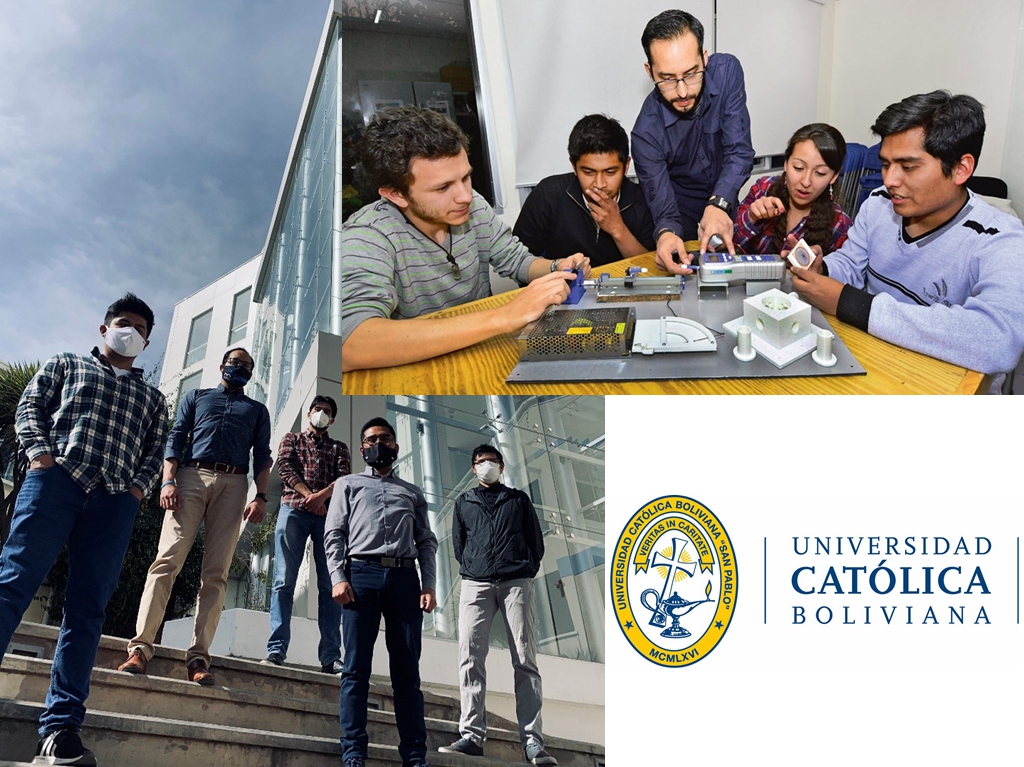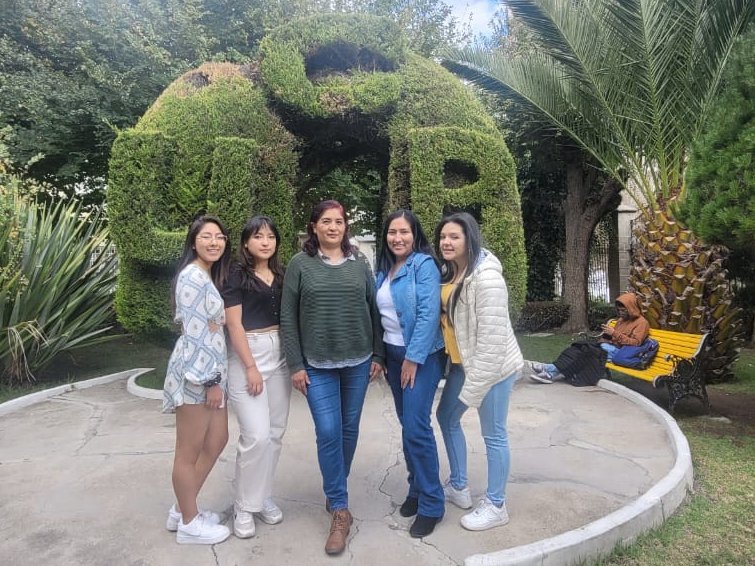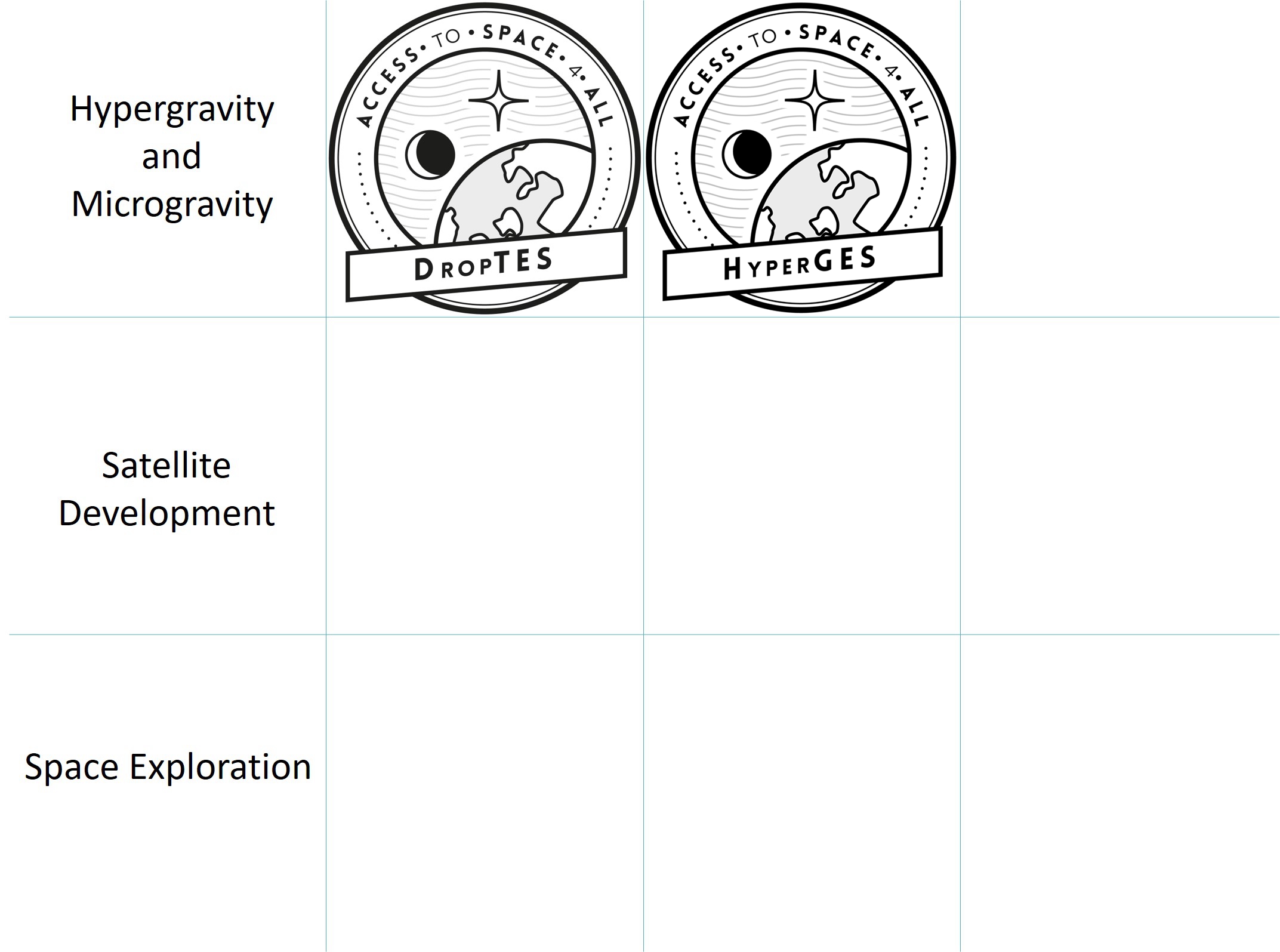Universidad Católica Boliviana "San Pablo", Bolivia

The two DropTES teams of Universidad Católica Boliviana "San Pablo" (Left: Team2020; Upper right: Team 2015). Credit: Fabio Richard Diaz Palacios
"Being accepted for the very first time as a Bolivian team to the DropTESprogram was such a life-changing opportunity, not just for the University itself, but for the students that usually have expectations to learn about space research and engineering. In the first project of 2015, we developed tests related to smart materials and biomedical devices for the heart, giving us the opportunity to analyze how our blood and medical devices perform under microgravity conditions. And for the second project of 2020, we developed a liquid 3D printing technic to be tested under microgravity conditions. This kind of program shows the students that nothing is impossible and even space research is reachable from any part of the world." - Eng. Fabio Richard Diaz Palacios, Mgr., Project Coordinator

The first Bolivian team awarded in the HyperGES. Credit: Georgina Aurelia Chávez Lizárraga
"This is a great chan for us to show that research is reachable for everybody and can be done at basic levels. We are very grateful to UNOOSA and ESTEC for giving us the opportunity to perform high-level experiments. With the use of the LDC, we will be able to get some insights about spacial anaemia and contribute also to understand how hypergravity affects the wall cell. As the first all-female team that won the HyperGES call we have a special responsibility to motivate young girls to pursue a STEM career. I also would like to remark that besides the experimental part, this experience is allowing us to develop other skills such as writing projects and articles, communication and building capacity." - Georgina Aurelia Chávez Lizárraga, Project Coordinator
AWARDS
DropTES
Universidad Católica Boliviana "San Pablo" was the winner of the 2nd round and 7th round of DropTES opportunities in 2015 and 2020.
The team's objective in 2015 was to examine and evaluate the property of an alloy of Nickel and Titanium "Nitinol" under a microgravity environment. Nitinol has a shape memory that allows it to return to its original form by heating after deforms. The team had an ambitious goal to apply this alloy to future space applications in order to reduce the complexity of design and lower costs. The team would also like to examine the possibility of using Nitinol in the medical field.
In 2020, the objective of the experiment is to determine the 3D printing feasibility under microgravity conditions, measure the intra-structure remaining liquid resin after light exposure, and compare manufacturing time, and amount of used material while processing the same piece between 2 different approaches.
HyperGES
In 2023, Universidad Católica Boliviana "San Pablo" was announced as one of the awardees in the 2nd round of the HyperGES programme. The project of Universidad Católica Boliviana "San Pablo", proposed by an all-female team, will examine how hypergravity affects the break-up of human red blood cells to get a better understanding of anaemia in space. The team will also highlight the efforts of Bolivian women in the space field.
News
- The "Casi Inges" team returns from their stage at ESA in the Netherlands (Spanish) (26 Dec 2023)
- Team members Belen Flores,Natalia Agramont, and Marcia Carrasco won the second place in the "HORIZON 2100" Competition in 2023 (Spanish) (22 Dec 2023)
- Bolivia's hypergravity blood cell test for astronaut health (19 Dec 2023)
- Young scientists study anemia in astronauts and won a scholarship in the European Space Agency(Spanish). (13 Sep 2023)
- "Casi Inges" on anemia in space (Spanish) (July 2023)
- UCB team won the HyperGES call and will travel to the Netherlands(Spanish) (29 June 2023)
- Students from Biochemistry and Bioprocess won the call HyperGES(Spanish) (11 May 2023)
- Teams from universities in Bolivia and Macao, China, selected for next fellowship on hypergravity experiments (8 May 2023)
- Bolivians doing science at the German Space Center (29 Jun 2022)
- Mechatronics Engineering is selected for research in Microgravity field (11 Sep 2020)
- A benchmark for the future, Bolivian technology tested in space conditions (20 May 2016)
- Bolivians doing science at the German Space Center (9 August 2015)
- 5 Bolivians will do science at Germany's space technology centre (1 August 2015)
Activities
- Team leader Georgina Chávez presented at the United Nations/World Health Organization International Conference on Space and Global Health in Geneve, Switzerland. (2 Nov 2023)
- Team leader Georgina Chávez participated in the 30th UN/IAF Workshop in Baku, Azerbaijan. (29 Sep 2023)
- PICA introduces the "Casi Inges" on YouTube (11 July 2023)
- Universidad Católica Boliviana team attended the ICMMT 2023 Congress (24 Mar 2023)
- Access to Space for All initiative for Sustainability: Interview Series Article #3 "DropTES: The Stepping Stone into Space Activities and its contribution to the SDGs" (30 September 2022)
- Interview with the team -The Bolivian team winners of the DropTES research fellowship: "We are creating a new 3D printing technique for space exploration" (10 September 2020)
Publications
- F. J. Ticona, F. R. Diaz, K. W. Vidaurre, C. R. Conchari, J. D. Valda, J. A. Condori. Main analysis for the disturbance torques over the Altiplano region for 1U CubeSat nadir earth pointing, 2022 IEEE ANDESCON , Barranquilla, Colombia, 2022, pp. 1-7, doi: 10.1109/ANDESCON56260.2022.9989853.
- F. R. Diaz, J. Ordoñez, G. A. Rojas M. A. Clavijo, G. Sahonero, R. R. Botelho, J. M. Valverde, G. E. Manning, R. A. Espinar, A. Montevilla, D. A. Suarez, O. Crispin, K. Nallar. MAMBU: A Bolivian Case of Response to Artificial Ventilators, 2022 IEEE ANDESCON, Barranquilla, Colombia, 2022, pp. 1-6, doi: 10.1109/ANDESCON56260.2022.9989651.
- A. A. Grover and R. S. Gabriel, " Analysis of Algorithmic Trading with Q-Learning in the Forex Market ," 2021 International Conference on Emerging Smart Computing and Informatics (ESCI), 2021, pp. 73-77, doi: 10.1109/ESCI50559.2021.9396948.
- A. A. Grover and R. S. Gabriel, " Design and Implementation of a Delta Robot Based on FPGA for the Automation of the Collection of Solid Products ," 2021 International Conference on Industrial Engineering, Applications and Manufacturing (ICIEAM), 2021, pp. 636-641, doi: 10.1109/ICIEAM51226.2021.9446417.
- Dariusz Zapała, Ali Hossaini, Mazaher Kianpour, Guillermo Sahonero-Alvarez & Aladdin Ayesh (2021) A functional BCI model by the P2731 working group: psychology , Brain-Computer Interfaces, DOI: 10.1080/2326263X.2021.1935124
- Chuck Easttom, Luigi Bianchi, Davide Valeriani, Chang S. Nam, Ali Hossaini, Dariusz Zapała, Avid Roman-Gonzalez, Avinash K Singh, Alberto Antonietti, Guillermo Sahonero-Alvarez, Pradeep Balachandran. (2021). A Functional Model for Unifying Brain Computer Interface Terminology . IEEE Open Journal of Engineering in Medicine and Biology, 2, 65-70
- I. R. Tiñini Alvarez and G. Sahonero-Alvarez, " Cross-View Gait Recognition Based on U-Net ," 2020 International Joint Conference on Neural Networks (IJCNN), 2020, pp. 1-7, doi: 10.1109/IJCNN48605.2020.9207501.
- C. Menacho and J. Ordoñez, " Fall detection based on CNN models implemented on a mobile robot ," 2020 17th International Conference on Ubiquitous Robots (UR), 2020, pp. 284-289, doi: 10.1109/UR49135.2020.9144836.
- J. Ordoñez and G. Sahonero-Alvarez, " A 3D Convolution Accelerator Implemented on FPGA Using SDSoC ," 2019 7th International Engineering, Sciences and Technology Conference (IESTEC), 2019, pp. 677-681, doi: 10.1109/IESTEC46403.2019.00126.
- G. Sahonero-Alvarez and H. Calderon, " Implementation Issues of Student-Centered Learning based Engineering Education in Developing Countries Universities ," 2018 World Engineering Education Forum - Global Engineering Deans Council (WEEF-GEDC), 2018, pp. 1-6, doi: 10.1109/WEEF-GEDC.2018.8629701.
- G. Sahonero-Alvarez, " Blockchain and Peace Engineering and its Relationship to Engineering Education ," 2018 World Engineering Education Forum - Global Engineering Deans Council (WEEF-GEDC), 2018, pp. 1-6, doi: 10.1109/WEEF-GEDC.2018.8629679.
- Fabio Diaz Palacios, Maritza Irahola Zalles, Jhon Ordoñez Ingali. Medical devices under microgravity conditions ISBN:978-6138578307, 2019
- I. R. Tiñini Alvarez and G. Sahonero-Alvarez, " Gait Recognition Based on Modified Gait Energy Image ," 2018 IEEE Sciences and Humanities International Research Conference (SHIRCON), 2018, pp. 1-4, doi: 10.1109/SHIRCON.2018.8592975.
- Guillermo Sahonero Alvarez, Susana Gloria Vargas Mendieta, and Jhon Abel Ordoñez Ingali, " Una revisión crítica del empleo de cuestionarios automáticos en el aprendizaje por computador para ingeniería ," in Congreso Internacional "La influencia de la tecnología en las comunidades del conocimiento", 2018.
- Murillo-Sanchez, X. A., Gutierrez-Rocha, A. L., Ibanez-Illanes, A. W., Quiroz-Perez, J. A., Sahonero-Alvarez, G., & Diaz-Palacios, F. R. (2018). Implementation de la metodologia SUM modificada para el desarrollo de videojuegos orientados al aprendizaje en Bolivia . In Cisci 2018-Decima Septima Conf. Iberoam. en Sist. Cibern. e Informatica, Decimo Quinto Simp. Iberoam. en Educ. Cibern. e Informatica, Sieci 2018-Memorias (Vol. 2, pp. 144-149).
- C. Gutierrez S. & G. Sahonero-Alvarez (2018). BLDC Motor Controller Response to PWM Compensation. CLCA 2018.
- Palacios, F. D., Zalles, M. I., Ingali, J. O., Arancibia, D. R., & Rojas, G. (2018). Mechanical features analysis of the Nitinol alloy under microgravity conditions . 42nd COSPAR Scientific Assembly, 42, G0-2.
- Sahonero-Alvarez, G., & Calderon, H. (2017, March). A comparison of SOBI, FastICA, JADE and Infomax algorithms . In Proceedings of the 8th International Multi-Conference on Complexity, Informatics and Cybernetics (pp. 17-22).







